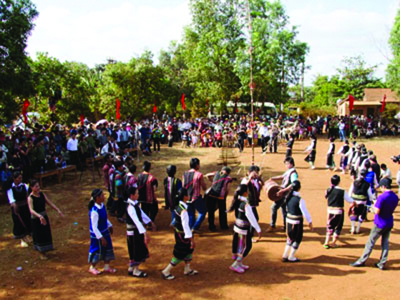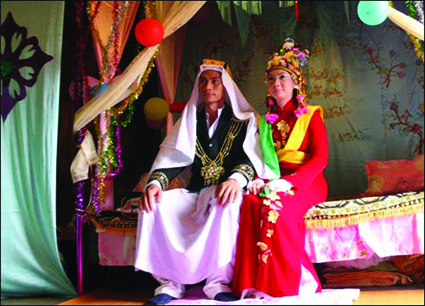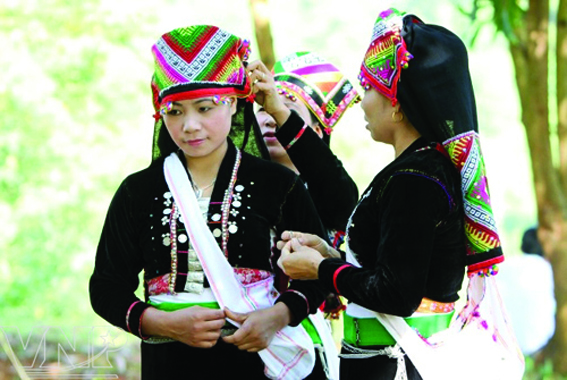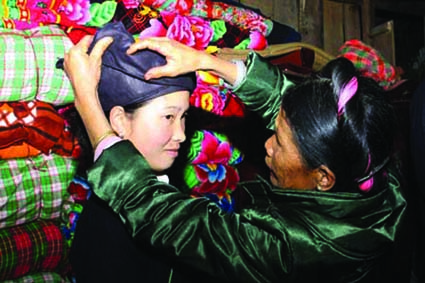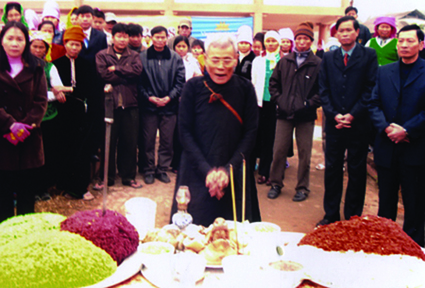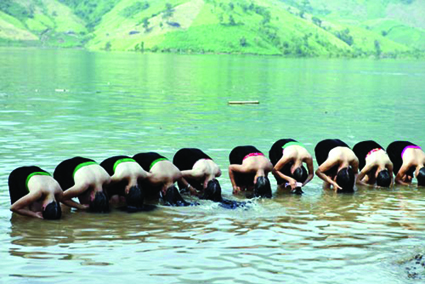>>Mourning rites of the Bahnar
>>Inheritance under Bahnar customary law
>>The “Bahnar” - their rules and customary practices
Ta Thi Tam
Ethnology Institute
Buffalo sacrifices play an important role in the spiritual as well as daily lives of Bahnar, the largest Mon Khmer language community in the Central Highlands.
Whether it is a new rice festival, a communal house celebration, or completion of a new home, the buffalo stabbing ritual is deemed indispensable for invoking divine blessings.
 |
| Performing rituals at a buffalo stabbing festival of the Bahnar (Gia Lai province)__Photo: Thanh Ha/VNA |
For the buffalo stabbing ritual, the Bahnar erect the gang tua brui, which is a beautifully decorated bamboo pole on which a fresh silk-cotton tree branch is hung. Around the pole to which the sacrificial buffalo will be tied are four pieces of wood decorated with bamboo tassels. The buffalo’s horns are also decorated with bamboo tassels and his forehead anointed with a triangle-shaped bamboo piece. A thread is put through the nose of the animal for all members of the host family to hold in turn before the ceremony, an act that shows gratitude to the buffalo for his sacrifice.
In this ceremony, the Bahnar also sacrifice a goat and kill a pig to make an offering of its liver. The ceremony starts with a prayer by the village patriarch for peace and prosperity for the village. After the prayer, a villager wraps a blanket around the pole to the sounds of drum and gong beats, while villagers wearing the traditional Bahnar dress move slowly around the pole to which the bull is tied with a big cord made particularly for this ceremony. Young girls, also attired in their traditional dress, take wine from a big jar through stalks to bamboo containers decorated with green, red and white patterns and offer them to the gong and drum players and other villagers who eat, drink and dance around the bull throughout the night.
Early next morning, the buffalo stabbing ritual begins to the sound of gong beats. In a series of moves, different parts of the bull are cut, and some of them given to the ceremonial assistants. As the Bahnar believe the bull’s head will lose its shape and be rejected by gods if it is burnt, it is impaled on the pole, while the remaining parts are roasted and divided equally among all villagers. Every villager receives two pieces of meat and a piece of skin. Pregnant women receive two portions. The remaining meat is cooked for a feast in which the special dish is grilled sausage made with the bull’s stomach, liver, large intestine and chillies. The sausage is cut into pieces and placed on a tray. The person who gets the piece filled with chilly is regarded as strong while the one who gets a piece with liver is considered brave. The villager who gets the piece with intestine filling faces derisive comments and laughter as the weak person.
At around four in the afternoon, villagers again go anticlockwise around the pole on which the bull’s head has been impaled. In the lead are young men playing gongs and drums, followed by girls who serve wine and meat to these players. The rest of the villagers dance cheerfully behind the first two groups. During this ritual, people thrust a stick at the bull’s head. If it falls to the east, the gods are believed to have accepted the offering, and will support the village. The head falling to the west is seen as a bad omen and a sign that the offering has been rejected. If this happens, the belief is that no divine support will be forthcoming.
The next day, the buffalo’s head is roasted for another feast that also lasts throughout the day.
The Bahnar also have the custom of sacrificing a white buffalo when the village is struck by lightning or when it celebrates the communal house. A white buffalo is also sacrificed when a villager suffers some serious sickness. The ceremony follows the same sequence and rituals as the black buffalo sacrifice.-

